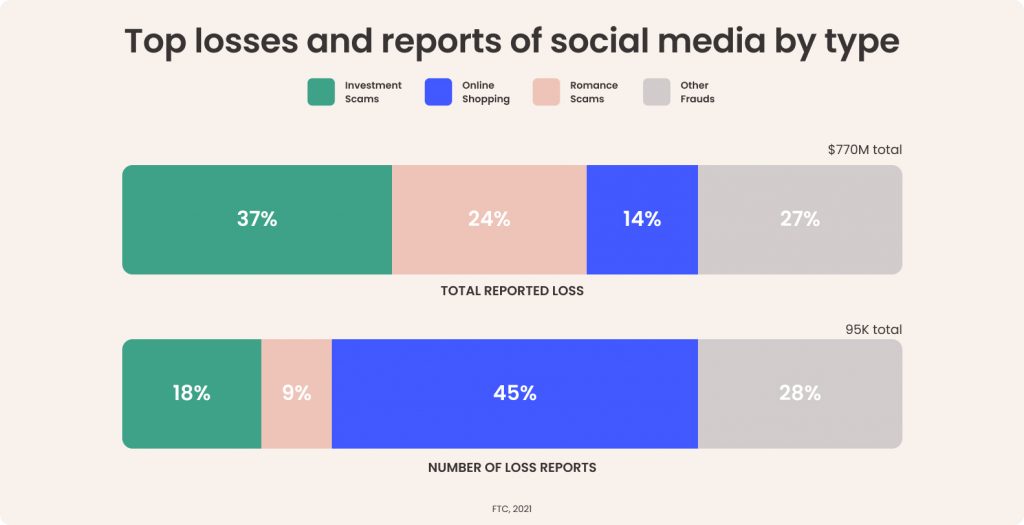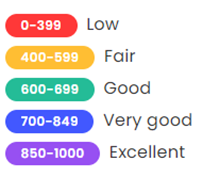- 오디오에서 추론→음성 생성→실시간 소통···구글, “대화가 AI와 소통하는 핵심적인 방법될 것”
- AI의 ROI : 과대포장보다 실질적인 효과가 중요한 이유
- Apple doesn't need better AI as much as AI needs Apple to bring its A-game
- I tested a Pixel Tablet without any Google apps, and it's more private than even my iPad
- My search for the best MacBook docking station is over. This one can power it all
The Gold Rush of Fraud: Why Scammers Have Flocked to Social Media

There’s millions of dollars to be made in social media. For scammers.
Americans lost nearly three-quarters of a billion dollars to social media fraud in 2021, signaling that social media may be the most profitable method of scamming victims—marking an 18-fold increase over 2017.
And that’s just cases of reported fraud.
Of the roughly 95,000 cases tallied in 2021, the actual number of reports and losses are arguably much higher because fraud victims infrequently report these crimes to the FTC or other agencies. Likewise, few take advantage of the FTC’s resources for recovering from fraud. Instead, they’ll share the sad news with family or friends if anyone at all.
Despite the rise of these online crimes, there are several things you can do to increase your awareness of social media fraud—what it looks like and how it’s pulled off—along with other ways you can prevent scammers from targeting you and the ones you care about.
What does social media fraud look like?
Several types of social media fraud abound, yet the FTC reports that three types of scams prevail:
Investment scams
These often involve bogus sites that promote opportunities to mine or invest in cryptocurrencies. Rather than use these sites to trade in legitimate cryptocurrencies, scammers use these as a front to collect funds. The funds are never invested and never returned. Thanks to social media, scammers have a quick and easy way to drive victims to such bogus sites.
Romance scams
By starting up a chat through an unexpected friend request or a message that comes out of the blue, a scammer develops a budding romantic relationship with a victim—and eventually starts asking for money. Public social media profiles are particularly attractive to scammers because they’re loaded with information that scammers can use to win a victim’s confidence or heart.
Online shopping scams
Using ads on social media, scammers drive victims to phony online stores that will take people’s money but that don’t deliver the goods. They’re simply a way for scammers to harvest cash from unsuspecting shoppers. These sites may impersonate reputable brands and stores or they may sell bogus products altogether. Either way, victims pay and receive nothing in return.
Together, these three types of scams accounted for the overwhelming majority of losses and reports of social media fraud, which are broken down in detail as follows:

As illustrated, investment and romance scams may get reported less frequently, yet they are among the costliest scams going on social media. Meanwhile, online shopping scams on social media are far more common yet rake in fewer dollars overall.
What makes social media such a happy hunting ground for scammers?
For one, reach. Nearly half of the global population uses social media today. That translates into billions of people who can be made into potential victims. Secondly, social media provides the tools to reach those people through the otherwise legitimate services and features available to the people and businesses that use social media to connect.
In the case of investment and shopping scammers, the ad platforms are of particular use. For romance scammers, direct messaging and profile pages are potential avenues for fraud.
Targeted ad platforms can be used to target victims
Scammers use the highly targeted ad platform that social media companies use to generate revenue. With millions of detailed user profiles in their data stores, social media companies put that data to work in their ad platforms allow businesses to create ads designed to reach specific age groups, hobbies and interests, past purchases, and so on. Just as easily, a scammer can use the same tools to cook up bogus ads for their bogus products, services, and sites at a relatively low cost.
For example, a scammer could target older females with an interest in investing. From there, the scammer could narrow down that target profile to those who live in areas of the country with a desired average income level, and who have shown interest in investment products before. The scammers would create an ad that takes them to phony website designed to entice that target group into purchasing a bogus product, service, or crypto. The FTC reports that the median loss for an online shopping scam in 2021 was $118, while online investment scams on social media racked up a median loss of $1,800 per victim. These stats make a strong case for sticking to reputable and established retailers and accredited financial services.
People love to share, and scammers love to turn that against their victims
In the case of romance scammers on social media, the posts and personal profiles that form the heart of social media offer con artists a treasure trove. With a potential victim’s life a relatively open book, full of birthdays, events, interests, and activities for all to see, scammers have the hooks they need to form a phony romantic relationship online—or at least make the attempt at one.
For example, a scammer reaches out to a potential victim with a friend request. With the profile and posts this romance scammer has at hand, they can spin all manner of intriguing, yet utterly false tales designed to gain the victim’s trust. With that trust established, they can follow up with a similarly intriguing story about needing “a little help” to cover some “unexpected expenses,” often in the form of a gift card or reloadable debit card—sometimes stringing out a series of requests over time. According to the FTC, the median loss for this type of romance scam in 2021 was around $2,000 per victim.
Six steps for preventing social media scams
People worldwide spend an average of 145 minutes a day on social media. And with users in the U.S. spending just over two hours on social media a day, that’s a great deal of potential exposure to scams.
Yet, whether you’re using Facebook, Instagram, TikTok, or whatnot, here are several things you can do that can help keep you safe and secure out there:
1. Set strong, unique passwords
Passwords mark square one in your protection, with strong and unique passwords across all your accounts forming primary line of defense. Yet with all the accounts we have floating around, juggling dozens of strong and unique passwords can feel like a task—thus the temptation to use (and re-use) simpler passwords. Hackers love this because one password can be the key to several accounts. Instead, try a password manager that can create those passwords for you and safely store them as well. Comprehensive security software will include one.
2. Go private
Social media platforms like Facebook, Instagram, and others give you the option of making your profile and posts visible to friends only. Choosing this setting keeps the broader internet from seeing what you’re doing, saying, and posting, which can help protect your privacy and give a possible scammer much less material to work with.
3. Say “no” to strangers bearing friend requests
Be critical of the invitations you receive. Out-and-out strangers could be more than just a stranger, they could be a fake account designed to gather information on users for purposes of fraud. There are plenty of fake accounts too. In fact, in Q3 of 2021 alone, Facebook took action on 1.8 billion fake accounts. Reject such requests.
4. Watch out for phishing scams
We’re increasingly accustomed to the warnings about phishing emails, yet phishing attacks happen plenty on social media. The same rules apply. Don’t follow any links you get from strangers by way of instant or direct messages. And keep your personal information close. Don’t pass out your email, address, or other info as well. Even those so-called “quiz” posts and websites can be ruses designed to steal bits and pieces of personal info that can be used as the basis of an attack.
5. Do a background check—on businesses and people
When you’re purchasing online, do some quick research on the company. How long have they been around? Have any complaints been recorded by your attorney general or local consumer protection agency? When you meet someone new, do a reverse image search on their profile pic to see where else it appears. Look up their name in search as well. If the results you find don’t match up with the person’s story, it may be a sign of a scam.
6. Protect yourself and your devices

Online protection software can protect you from clicking on malicious links while on social media while steering you clear of other threats like viruses, ransomware, and phishing attacks. It can look out for you as well, by protecting your privacy and monitoring your email, SSN, bank accounts, credit cards, and other personal information. With identity theft a rather commonplace occurrence today, security software is really a must. Additionally, our online protection software can also provide you with an online Protection Score that shows you just how safe you are. From there, it calls out any weak spots and then walks you through the steps to shore it up with personalized guidance.
Protect yourself and others from social media scams
It’s unfortunate seeing a resource we’ve come to know and love over the past years get taken advantage of this way. Yet taking the steps outlined above can go a long way to prevent it from happening to you or someone you love.
One important note is to strongly consider filing a report if you believe you’ve been a victim of a social media scam. While some of the scammers behind these crimes are small-time operators, there are larger, almost business-like operations that conduct these crimes on a broader and sometimes international scale. So whether filing a report will help you recover some or all your losses, it can provide information to businesses and agencies that can help keep it from happening to others.
For more on online theft and fraud, and how you can spot and report it, check out our article on the topic. Doing so may help you, and someone else as well.

